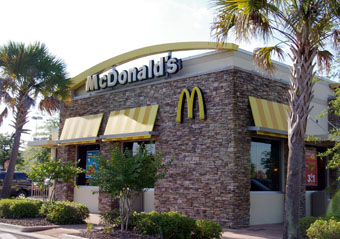
McDonald’s Posts Another Decline
| published April 23, 2015 |
By Thursday Review staff writers
McDonald’s has had six straight declines in six quarters, and their most recent 90 days may have been the worst in the company’s long history. In the three months ending March 31, McDonald’s saw its sales fall 2.3 percent worldwide, and 2.6 percent in the United States. Net income fell 32.6—one of its biggest drops ever.
The once-unstoppable fast food giant has lost vast amounts of market share in recent years—in part because of heightened awareness about health, diet and obesity. But McDonald’s has also lost ground because of rapidly the shifting preferences of consumers no longer interested in the traditional McDonald’s formula. Many younger diners—and by younger we mean those under the approximate age of 35—are drawn instead to the popular fast-casual restaurant segment, a broad category which includes chains like Panera, Chipotle, Five Guys, Zaxby’s, Culvers, Moe’s, and The Shake Shack.
McDonald’s has also taken a beating at the hands of Chick-fil-A, which has ascended rapidly to become one of North America’s biggest restaurants—toppling KFC in sales of chicken products and outperforming McDonald’s and Burger King in terms of unit profitability.
Attempting to halt the hemorrhage, McDonald’s marketers have deployed numerous gimmicks to draw people back to the store—most recently a retro-styled advertising campaign in which viewers are enticed with happy associations and fond memories of what McD’s used to be in their golden age of burgers and fries. Some ads are attempts at one-upmanship: a triple-decker burger meant to rival the oversized menu items of That ad campaign can still be seen in prime time most nights, but industry insiders say that it has failed to shepherd the old customers back, nor has it had any effect on McDonald’s continuing losses among the under-30 crowd.
McDonald’s is also conflicted from within about its menu, with two camps—those who want to expand the menu aggressively to co-opt some of the same footprint now making restaurants like Chipotle and Panera so popular; and those who argue that the menu it already too complex and baroque, and suggest that less is more. One chief complaint about McDonald’s—from all age groups—service is too slow and too often fraught with confusion and error (as anyone can attest to when they have exited the drive-through with someone else’s food order).
Another problem for McDonald’s: they consistently land on the wrong side of the strident debates about health, diet and food safety—especially concerns about genetically-modified foods and animals raised with antibiotics. New McDonald’s CEO Steve Easterbrook says that the company will begin immediately improving and modifying its ways in these arenas, and—like Chick-fil-A—has agreed to gradually reduce antibiotic content in products made with chicken.
Easterbrook and the top brass at McDonald’s hope to allay the fears of investors who worry that McDonald’s slide may continue for a couple of years as the restaurant segment of the economy grows in both diversity and the aggressive courting of the tastes of younger diners. Though it is unlikely that the Golden Arches will succumb to market forces with the same epic failure seen by Radio Shack, now in its death throes, some restaurant analysts wonder if McDonald’s has waited too long to address its bad positioning on health, diet, and food quality.
Easterbrook, who previously served as McDonald’s chief branding officer, was promoted back in March to the top spot after the departure of Don Thompson.
Related Thursday Review articles:
Can McDonald’s Halt its Decline?; Thursday Review staff; Thursday Review; March 10, 2015.
Can Popeye’s Stay Ahead of the Fast Food Decline?; Thursday Review; March 10, 2015.
